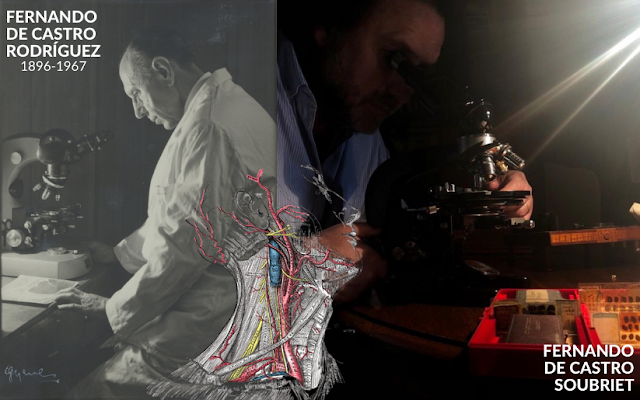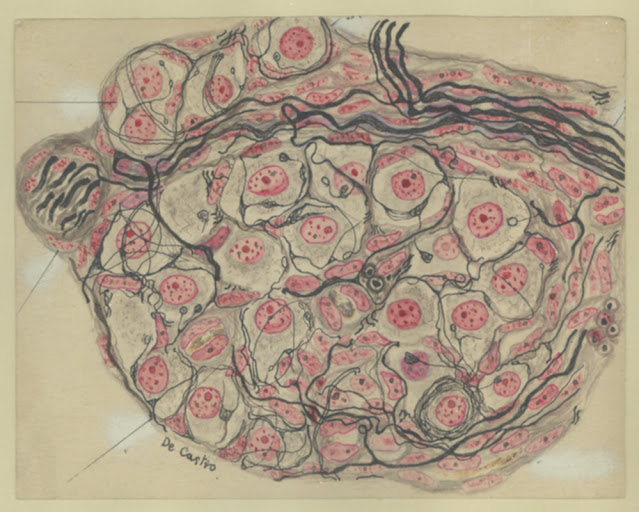HORSE OF CUPS
FERNANDO DE CASTRO RODRÍGUEZ
Horse of Cups: FERNANDO DE CASTRO RODRÍGUEZ (1896 -1967), the great neurophysiologist of the sympathetic

We present Fernando de Castro, one of the stars of the Cajal galaxy, who rides in the neurodeck representing the astrocytes of the suit of Cups. The “disciple in training and with promises of optimal fruits” that Cajal integrated into the select staff of his Spanish Neurological School became one of his closest collaborators. An excellent draftsman and undisputed expert on the sympathetic system, he was awarded a Nobel Prize that he did not share with the Belgian Corneille Heymans in 1938 due to the Civil War.
Life is transmitted from generation to generation, and this transmission maintains the extreme diversity and complexity of life. Genetics doesn’t explain everything, and the De Castro family is a prime example that we inherit much more than the combinations of genes from our parents. Grandfather and grandson share a first and last name: Fernando de Castro. And something much more important: his passion for neurobiology.

The grandfather, Fernando de Castro Rodríguez, was, together with Rafael Lorente de Nó, the last and youngest of Cajal’s direct disciples. De Castro worked both in the laboratory of the University of Madrid, where Cajal had a chair in Histology and General Embryology, and at the Cajal Institute. He obtained multiple awards and recognitions for his work, was elected a member of the Royal Academies of Medicine and Sciences, and achieved the respect and international recognition of scientists, such as Wilder G. Penfield. Unfortunately, at the height of his scientific career the Spanish Civil War broke out, and during the post-war period nothing was the same again.
Like Santiago Ramón y Cajal, he was always committed to ensuring that science contributed to the prestige of his country. In the purest Cajalian line, he tirelessly searched for a physiological explanation for what the microscopic preparations showed.
He is one of the scientists who has contributed the most to the knowledge of the tissues of different nervous structures, especially the sympathetic and parasympathetic systems involved in the reflex phenomena that regulate circulation and breathing. Despite being the first to describe arterial chemoreceptors, he was not the one who received the Nobel Prize in Physiology or Medicine in 1938, but rather the Belgian Corneille Heymans, who supported his research on the theories of a De Castro immersed in chaos at that time. of the Spanish Civil War.

Carotid sinus stained with methylene blue. Drawing by Fernando de Castro Rodríguez

Carotid body. Drawing by Fernando de Castro Rodríguez
(images: Fernando de Castro Archive)
His work regarding the structure and function of the sensory ganglia (1921-1922) and the structure and innervation of the glomus or carotid body (1927-1928) demonstrated three fundamental aspects:
The existence of sensory endings that are sensitive to the pressure of the carotid sinus wall.
The glomus or carotid body is a sensory organ sensitive to changes in the chemical composition of the blood.
Sensory fibers from the sinus in the glomus join the first branch of the glossopharyngeal nerve.
Those who knew him speak of someone introverted and sparse in words, elegant in his actions and devoted to his teachers (Achúcarro, Tello and Cajal). He was part of Don Santiago’s circle of intimate collaborators and friends. Together with Francisco Tello he successfully defended all the equipment and belongings of the Cajal Institute during the Civil War. and both were in charge of guarding his legacy. Proof of the trust that Santiago Ramón y Cajal placed in them is that they both signed works with him. Among Fernando de Castro’s many publications, the book Micrographic Technique of the Nervous System (Madrid, 1933) stands out, which he signed with Cajal to methodically and exhaustively compile the most appropriate existing techniques to carry out the finest neurohistological studies.
Don Santiago detected his scientific virtues very early and, between 1924 and 1932, he chose him to train fellows and visitors (national and foreign) in neurohistological techniques and to transmit the pillars of his scientific model: logical approach, impeccable technique, precise scientific writing. and refined, as well as self-criticism and sincerity with oneself. With De Castro and Lorente de Nó (knight of Swords of the neurodeck) the Spanish Neurological School opened to neurophysiology.
The grandson, Fernando de Castro Soubriet, is a senior scientist at the Higher Council for Scientific Research and currently directs the Developmental Neurobiology Group at the Cajal Institute, which he founded in 2003. He came into the world when his grandfather abandoned him, but he keeps his memory as the current heir and owner of the Fernando de Castro Archive, a unique collection of his grandfather’s documents and scientific objects that, finally in 2017, was recognized and inscribed by UNESCO in the Memory of the World Registry.
Two Fernandos, two doctors, two researchers who talk face to face with neurons. Simple coincidence? Click on the image to see the interview with Fernando de Castro Soubriet, because you will learn many things about Spanish neuroscience from the first half of the 20th century and today.
Have you been curious and want to know more?
Sources consulted about his biography:
Spanish Society of Neuroscience (SENC): “Meet the neuroscientists who have made history” Fernando de Castro Rodríguez: https://www.senc.es/wp-content/uploads/2020/12/Biograf%C3%ADa-FdeCastro -Rodr%C3%ADguez-para-SENC-History.pdf
Royal Academy of History: Electronic Biographical Dictionary (DB-e), entry Fernando de Castro Rodríguez https://dbe.rah.es/biografias/11679/fernando-de-castro-rodriguez, by Manuel Díaz-Rubio García
A Hombros de Gigantes (RNE), Series about Santiago Ramón y Cajal, his school and his legacy. Podcast from 07/04/2021 (LISTEN MINUTES 21:43 to 54:35): His grandson, Fernando de Castro Soubriet brings us closer to the figure of his grandfather, the doctor Fernando de Castro Rodríguez, the last direct disciple of our Nobel Prize winner https: //mediavod-lvlt.rtve.es/resources/TE_SAHOMB/mp3/5/8/1625220771985.mp3
GÓMEZ SANTOS, Marino (2009): Fernando de Castro. His life. His work. Mutua Madrileña Medical Foundation, Madrid. 261 pp.
Contributions from Fernando de Castro Rodríguez and the Spanish School of Neurology:
DE CASTRO, F. (2019). Cajal and the Spanish Neurological School: Neuroscience Would Have Been a Different Story Without Them. Front. Cell. Neurosci. 13:187. https://doi.org/10.3389/fncel.2019.00187
DE CASTRO, F. (2009). The Discovery of Sensory Nature of the Carotid Bodies – Invited Article. In: Gonzalez, C., Nurse, C.A., Peers, C. (eds) Arterial Chemoreceptors. Advances in Experimental Medicine and Biology, vol 648. Springer, Dordrecht. https://doi.org/10.1007/978-90-481-2259-2_1.
DE CASTRO, F. (2009). Towards the sensory nature of the carotid body: Hering, De Castro and Heymans. Front. Neuroanat. 3:23. https://doi.org/10.3389/neuro.05.023.2009
Publications by Fernando de Castro Rodríguez:
In addition to his many scientific contributions, Fernando de Castro published numerous historical works on the life and work of prominent members of the Spanish histological school. You can see it here: https://scholar.google.es/citations?user=afyFoEkAAAAJ&hl=en&authuser=1
